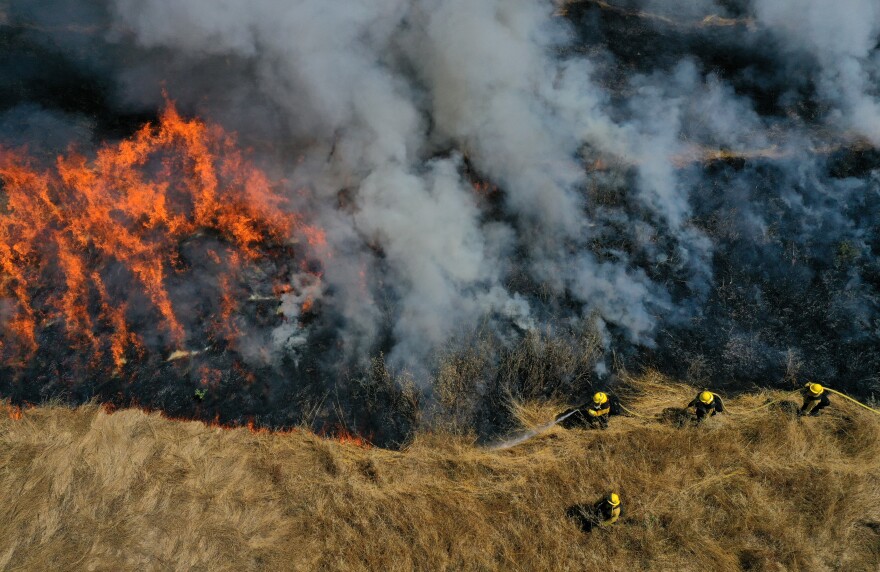Truth matters. Community matters. Your support makes both possible. LAist is one of the few places where news remains independent and free from political and corporate influence. Stand up for truth and for LAist. Make your year-end tax-deductible gift now.
It's Been A Wet Year, But Flash Fires Could Hit SoCal When Heat Returns

Southern Californians are enjoying a respite from wildfires as frequent storms and cool temperatures keep what feels like a wet blanket over much of the Southland.
Fast-growing chaparral plants such as grasses and mustard are soaking up the moisture and shooting up in height, taking advantage of the saturated soil and lack of drought.
But those lush, verdant hillsides will soon dry out, as May Gray and June Gloom drop off and Santa Ana winds return. That will leave tinder-dry conditions throughout much of the county and the potential for numerous “flash fires” — sudden, intense fires that rip through vegetation and can be caused by a single spark.
“When we talk about grassy fuels people say, ‘It's just grass,’ but when you're looking at some of this grass, it’s 7, 8, 10 feet tall,” said Los Angeles County Fire Captain Sheila Kelliher Berkoh.
“On a hot day, when the wind is blowing, we can still see some pretty big fires. We had one out in the Antelope Valley that got to 1,300 acres pretty quick and it was all flash fuels,” she said.
These fast-moving fires are often caused by people — sometimes from cigarettes being thrown out of cars or sparks from machinery and vehicles. They can quickly burn structures and homes but are less likely to grow into the megawatt blazes that have become the norm. But if a big enough grass fire keeps burning under the right conditions, Kelliher Berkoh says it could take off.
“If you just try to light a log, it's not going to light, but you put a bunch of light flashy fuels under there, you're going to generate enough heat to finally get that big log burning,” she said.
Where’s all that snow?
Most of it is still in the mountains. The Southern Sierra Nevada snowpack is at 435% of normal for this time of year, indicating a gradual melt so far. That’s good news for forested areas around timberline where snow is still on the ground, where the slow-melting snowpack has given higher elevations a buffer against massive forest fires.
The National Interagency Fire Center predicts large fire activity will be below normal in the higher elevations through September as the snowpack continues to melt and keeps soil moisture high.

What is SoCal’s fire outlook?
Experts say the potential for a significant fire will remain below normal across the region in June, except in areas across the San Joaquin Valley and deserts, which dry out faster.
The National Interagency Fire Center experts also expect the marine layer to remain deep throughout the month, keeping our fire potential low. The fire risk will rise in July as the marine layer becomes shallow and the scrub brush dries out.
Create defensible space before it's too late
The green grasses around your home will soon become a liability, so start your brush clearance now.
“If you provide the defense, we'll provide the offense,” Kelliher Berkoh said. “And the defense is brush clearance from about 200 feet away from your home, getting all those flashy grassy fuels knocked down to about two to three inches only,” she said.
She recommends removing debris from underneath bushes and trimming trees that touch the roof. To prevent flying embers from getting stuck and setting your house on fire, fix holes or spaces around your attic or between your roofline and house.
“If we did get a high wind day and those flashy fuels ignite as that fire blows by, it will keep embers from getting stuck in your house and causing an after ignition,” she said.
LAist: Tips and Explainers
- Listen to The Big Burn, our podcast that will get you motivated to get ready
- Wildfires are getting worse. What you need to know
- Understanding climate change may help you feel less helpless
- Every day is now fire season. Let's get you ready for the next wildfire burning near you
- Evacuation terms can be confusing. Here’s what they mean and how to sign up for alerts
- How to keep yourself safe from wildfire smoke
- The air is brown — should I wear a mask? We tested 5 out and have some advice
- This is why fire officials don't want you to stay and defend your home
- What does 'containment' of a fire mean, exactly
- How to avoid getting towed during LA's red flag parking restrictions
- What to do — and not do — when you get home after a wildfire
- If you want to help fire victims, resist the urge to volunteer







